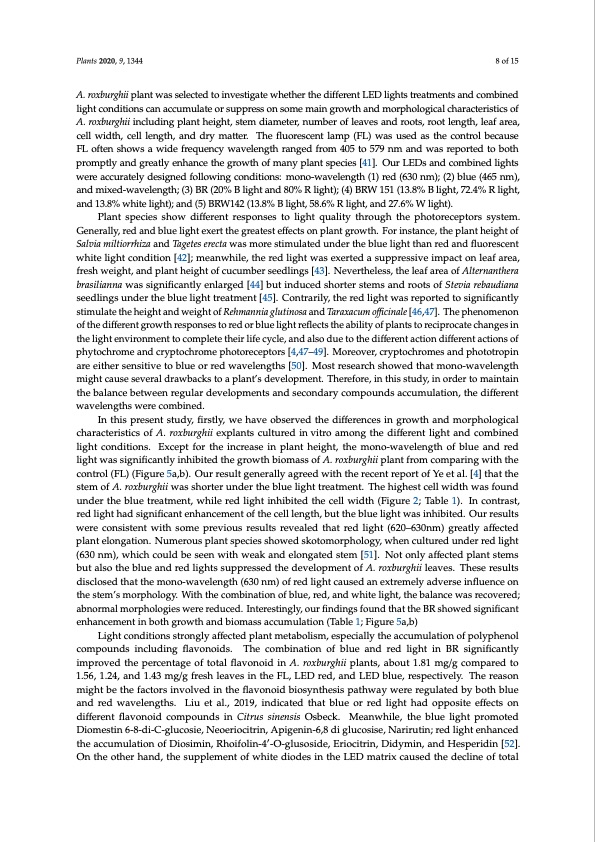
PDF Publication Title:
Text from PDF Page: 008
Plants 2020, 9, 1344 8 of 15 A. roxburghii plant was selected to investigate whether the different LED lights treatments and combined light conditions can accumulate or suppress on some main growth and morphological characteristics of A. roxburghii including plant height, stem diameter, number of leaves and roots, root length, leaf area, cell width, cell length, and dry matter. The fluorescent lamp (FL) was used as the control because FL often shows a wide frequency wavelength ranged from 405 to 579 nm and was reported to both promptly and greatly enhance the growth of many plant species [41]. Our LEDs and combined lights were accurately designed following conditions: mono-wavelength (1) red (630 nm); (2) blue (465 nm), and mixed-wavelength; (3) BR (20% B light and 80% R light); (4) BRW 151 (13.8% B light, 72.4% R light, and 13.8% white light); and (5) BRW142 (13.8% B light, 58.6% R light, and 27.6% W light). Plant species show different responses to light quality through the photoreceptors system. Generally, red and blue light exert the greatest effects on plant growth. For instance, the plant height of Salvia miltiorrhiza and Tagetes erecta was more stimulated under the blue light than red and fluorescent white light condition [42]; meanwhile, the red light was exerted a suppressive impact on leaf area, fresh weight, and plant height of cucumber seedlings [43]. Nevertheless, the leaf area of Alternanthera brasilianna was significantly enlarged [44] but induced shorter stems and roots of Stevia rebaudiana seedlings under the blue light treatment [45]. Contrarily, the red light was reported to significantly stimulate the height and weight of Rehmannia glutinosa and Taraxacum officinale [46,47]. The phenomenon of the different growth responses to red or blue light reflects the ability of plants to reciprocate changes in the light environment to complete their life cycle, and also due to the different action different actions of phytochrome and cryptochrome photoreceptors [4,47–49]. Moreover, cryptochromes and phototropin are either sensitive to blue or red wavelengths [50]. Most research showed that mono-wavelength might cause several drawbacks to a plant’s development. Therefore, in this study, in order to maintain the balance between regular developments and secondary compounds accumulation, the different wavelengths were combined. In this present study, firstly, we have observed the differences in growth and morphological characteristics of A. roxburghii explants cultured in vitro among the different light and combined light conditions. Except for the increase in plant height, the mono-wavelength of blue and red light was significantly inhibited the growth biomass of A. roxburghii plant from comparing with the control (FL) (Figure 5a,b). Our result generally agreed with the recent report of Ye et al. [4] that the stem of A. roxburghii was shorter under the blue light treatment. The highest cell width was found under the blue treatment, while red light inhibited the cell width (Figure 2; Table 1). In contrast, red light had significant enhancement of the cell length, but the blue light was inhibited. Our results were consistent with some previous results revealed that red light (620–630nm) greatly affected plant elongation. Numerous plant species showed skotomorphology, when cultured under red light (630 nm), which could be seen with weak and elongated stem [51]. Not only affected plant stems but also the blue and red lights suppressed the development of A. roxburghii leaves. These results disclosed that the mono-wavelength (630 nm) of red light caused an extremely adverse influence on the stem’s morphology. With the combination of blue, red, and white light, the balance was recovered; abnormal morphologies were reduced. Interestingly, our findings found that the BR showed significant enhancement in both growth and biomass accumulation (Table 1; Figure 5a,b) Light conditions strongly affected plant metabolism, especially the accumulation of polyphenol compounds including flavonoids. The combination of blue and red light in BR significantly improved the percentage of total flavonoid in A. roxburghii plants, about 1.81 mg/g compared to 1.56, 1.24, and 1.43 mg/g fresh leaves in the FL, LED red, and LED blue, respectively. The reason might be the factors involved in the flavonoid biosynthesis pathway were regulated by both blue and red wavelengths. Liu et al., 2019, indicated that blue or red light had opposite effects on different flavonoid compounds in Citrus sinensis Osbeck. Meanwhile, the blue light promoted Diomestin 6-8-di-C-glucosie, Neoeriocitrin, Apigenin-6,8 di glucosise, Narirutin; red light enhanced the accumulation of Diosimin, Rhoifolin-4′-O-glusoside, Eriocitrin, Didymin, and Hesperidin [52]. On the other hand, the supplement of white diodes in the LED matrix caused the decline of totalPDF Image | LED Lights Promote Growth and Flavonoid Accumulation of Anoectochilus roxburghii

PDF Search Title:
LED Lights Promote Growth and Flavonoid Accumulation of Anoectochilus roxburghiiOriginal File Name Searched:
plants-09-01344.pdfDIY PDF Search: Google It | Yahoo | Bing
Cruise Ship Reviews | Luxury Resort | Jet | Yacht | and Travel Tech More Info
Cruising Review Topics and Articles More Info
Software based on Filemaker for the travel industry More Info
The Burgenstock Resort: Reviews on CruisingReview website... More Info
Resort Reviews: World Class resorts... More Info
The Riffelalp Resort: Reviews on CruisingReview website... More Info
| CONTACT TEL: 608-238-6001 Email: greg@cruisingreview.com | RSS | AMP |